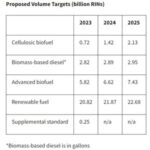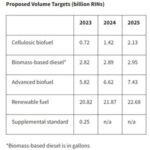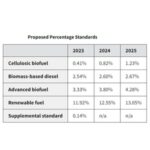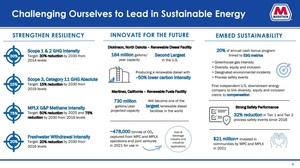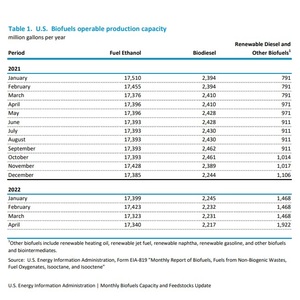EPA issue final RVO, biointermediates rule and denies 69 SREs
Energy Disrupter
ADVERTISEMENT
The U.S. EPA on June 3 finalized the 2021 and 2022 Renewable Fuel Standard renewable volume obligations (RVOs), reduced the existing RVO for 2022, denied 69 small refinery exemption (SRE) petitions, proposed an alternative renewable identification number (RIN) retirement schedule for small refineries, and extended an alternative compliance approach for certain small refineries, as established in April, to three additional refineries. These RFS-related provisions were taken in four separate actions announced by the EPA on June 3.
The first action is a final rule that sets 2020, 2021 and 2022 RVOs and makes other regulatory changes to the RFS, including provisions related to the use of biointermediates. That rulemaking was originally proposed in December 2021.
For RFS compliance year 2020, the EPA has finalized a proposed reduction of the exiting RVO. A rulemaking finalized in late 2019 initially set the total 2020 RVO at 20.09 billion gallons, with nested RVOs of 590 million gallons of cellulosic biofuel, 2.43 billion gallons of biomass-based diesel, and 5.09 billion gallons of advanced biofuel. The EPA is retroactively reducing those RVOs in line with the volumes proposed in December 2021. The total 2020 RVO is now set at 17.13 billion gallons, including nested RVOs of 510 million gallons for cellulosic biofuel, 2.43 billion gallons of biomass-based diesel and 4.63 billion gallons of advanced biofuel.
The EPA has finalized the total RVO for 2021 at 18.84 billion gallons, up from a proposed 18.52 billion gallons. That volume includes 560 million gallons of cellulosic biofuel, down from a proposed 620 million gallons; 2.43 billion gallons of biomass-based diesel, in line with the December proposal; and 5.05 billion gallons of advanced biofuel, up from a proposed 5.2 billion gallons.
For 2022, the EPA has set the final RVO at 20.63 billion gallons, down from a proposed 20.77 billion gallons. The 2022 RVO includes nested volumes of 630 million gallons of cellulosic biofuel, down from a proposed 770 million gallons; 2.76 billion gallons of biomass-based diesel, a volume maintained from the December proposal; and 5.63 billion gallons of advanced biofuel, down from a proposed 5.77 billion gallons. The 250 million gallon “supplemental obligation” for 2022 was also finalized. That “supplemental obligation” addresses remand of the 2014-2016 annual rule by the DC Circuit Court of Appeals in Americans for Clean Energy v. EPA. An additional 250 million gallon “supplemental obligation” is planned for 2023.
According to the EPA, the percentage standard for 2020 is now 10.82 percent total renewable fuel, with the nested standards of 0.32 percent cellulosic biofuel, 2.3 percent biomass-based diesel, and 2.93 percent advanced biofuel. The percentage standard for 2020 was originally set at 11.56 percent total renewable fuel, including the nested standards of 0.34 percent cellulosic biofuel, 2.1 percent biomass-based diesel, and 2.93 percent advanced biofuel.
The percentage standard for 2021 for total renewable fuel is 11.19 percent, including the nested standards of 0.33 percent cellulosic biofuel, 2.16 percent biomass-based diesel, and 3 percent advanced biofuel. For 2022, the percentage standard for total renewable fuel is 11.59 percent, including the nested standards of 0.35 percent cellulosic biofuel, 2.33 percent biomass-based diesel, and 3.16 percent advanced biofuel.
The rulemaking also finalizes several regulatory changes to the RFS program, including those for the use of biointermediates to produce qualifying renewable fuel, flexibilities for regulated parties, and clarifications of existing regulations.
The provisions related to biointermediates enact new compliance requirements that apply when renewable fuel is produced through sequential operations at more than one facility. The new regulations focus on the production, transfer and use of biointermediates, including recordkeeping and reporting requirements. The rule includes specific provisions for the use of biocrude, free fatty acid (FFA) feedstock, and undenatured ethanol used as biointermediates. It also addresses the use of biomass-based sugars, digestate, glycerin and other biointermediate feedstocks. The rule, however, does not address the use of biogas as a biointermediate. In the rule, the agency said it plans to address the use of biogas as a biointermediate when it addresses issues related to the use of biogas to make renewable electricity (eRINs) in a future action.
Under the rule, the EPA has finalized a requirement that the processing of a biointermediate must occur at a single facility before the biointermediate is transported to a renewable fuel production facility. The rule also restricts the transfer of biointermediates from a biointermediate production facility to a single renewable fuel production facility. Renewable fuel production facilities, however, may receive biointermediates from multiple biointermediate production facilities.
In a second action, the EPA denied 69 pending SREs. The agency had proposed to issue those denials in December 2021. The 69 denied SREs span RFS compliance years 2016 through 2021. The agency said the denials are consistent with a decision issued in April denying 36 SRE petitions for compliance year 2018. According to a statement released by the EPA, the SRE denials are consistent with a U.S. Court of Appeals for the Tenth Circuit holding in Renewable Fuels Association et al. v. EPA. In that ruling, the court said SREs may only be granted when a small refinery’s hardship is caused by compliance with the RFS program.
Although the members of the biofuel industry applauded the EPA’s April action to deny those 36 SREs for 2018, they also criticized the agency for failing to remedy demand destruction. The 31 small refineries that had previously approved SRE petitions overturned by the decision were provided with an alternative approach to demonstrate compliance with their RVOs for 2018. That alternative approach allows those 31 small refineries to resubmit their 2018 RFS annual compliance reports with zero deficit carryforward and no additional RIN retirements.
In a third action issued June 3, the EPA took final action to extend that alternative compliance approach to three of the 69 SREs denied on June 3. The three SREs are for compliance years 2016 and 2017.
Finally, the fourth action issued by EPA is a proposed rule that aims to provide an alternative RIN retirement schedule for small refineries that would provide them with additional time and a broader range of RINs to comply with their 2020 RFS obligations. The EPA said it proposing the alternative RIN retirement schedule because the agency has determined that there are extenuating circumstances specific to the 2020 compliance year, including a limited availability of RINs and the significant delay in EPA issuing its decisions on SRE petitions. A public hearing on the proposed rule is scheduled for June 28. A public comment period will be open through July 28, according to the agency.
Full copies of all four actions, along with supporting documentation, is available on the EPA website.
The RFA said the EPA’s June 3 actions on the RFS restore order in the program and provide a solid foundation for growth. “At long last, the RFS is being put back on track,” said Geoff Cooper, president and CEO of the RFA. “Today’s actions by EPA and the Biden administration restore integrity and stability to the RFS program after several years of wanton mismanagement and abuse by the previous administration. The combination of a strong RVO for 2022, restoration of illegally waived volume from 2016, and a new direction for the SRE program puts the RFS program on solid footing for the future. We thank Administrator Regan and President Biden for honoring their commitments to implement the RFS in a way that is fair, transparent, and focused on growth.”
Cooper also noted that today’s package couldn’t have come at a more important time, as consumers are facing record-high gas prices driven by instability in global energy markets. “By requiring petroleum refiners to blend larger volumes of low-cost biofuels like ethanol, today’s actions will put downward pressure on gas prices and provide economic relief to American families facing record-high pump prices,” he said. “In the last few days alone, wholesale ethanol prices have been as much as $1.30 per gallon lower than gasoline, leading to significant savings at the pump for consumers of ethanol-blended fuels like E10, E15, and E85.”
The American Coalition for Ethanol voiced disapproval of the EPA’s decision to retroactively reduce the 2020 RVO, but welcomed the agency’s actions to increase the 2021 RVO and deny 69 SREs. “While we strongly object to the unnecessary retrospective cut EPA is making to 2020 volumes, we are pleased the Agency is upwardly revising the 2021 volumes to align more closely with actual consumption and upholding base conventional volume of 15 billion gallons for 2022, along with 250 million supplemental gallons to address the DC Circuit court order in 2017,” said Brian Jennings, CEO of ACE. “ACE members are also thankful EPA is reining in the abusive use of SRE waivers pioneered under the last Administration.
“When taken as a whole, today’s actions begin to get the RFS back on track and fulfill Administrator Regan’s commitment to follow the law and science when it comes to this program,” Jennings continued. “However, continued vigilance is required to undo prior and prevent future mismanagement of the RFS — the only tool at EPA’s disposal to replace expensive foreign fossil fuel with low-cost, low-carbon and homegrown biofuels such as ethanol. Given pump prices remain at record high levels and the need to decarbonize the transportation sector, it’s particularly important to leverage the program’s full potential.
“We encourage EPA to utilize the upcoming RFS ‘set’ rule for post-2022 volumes to make good on Administrator Regan’s statement that ‘biofuels will be part of the solution for climate change and lowering prices at the pump,’” Jennings added.
Growth Energy said the EPA’s forward-looking RVOs for 2022 will ensure greater access of lower-cost, lower-carbon fuel at the pump. “These last six months have been a rude awakening for those who have grown complacent about U.S. energy supplies,” said Emily Skor, CEO of Growth Energy. “EPA’s 2022 renewable fuel blending requirements will deliver savings at the pump for working families, slash carbon emissions, and strengthen U.S. energy security by bringing more American renewable fuel into our fuel supply.
“In just the last few months, E15 has been a shield against skyrocketing fuel prices, saving drivers almost $0.60 per gallon in some areas while American biofuels cut greenhouse gas emissions by 46 percent compared to gasoline,” she added.
“We applaud President Biden and his EPA for this action, which will set the direction of total and advanced renewable fuel volumes for 2023 and beyond,” Skor said. “By setting conventional implied 2022 RVO volumes at 15 billion gallons, coupled with restoring the first 250 million gallons that had been illegally waived in the 2016 RVO, EPA underscores the critical role biofuels play – and will continue to play – in mitigating climate change and lowering prices at the pump. Moreover, it sends a positive signal as the agency works through its new rule – “the Set” – that picks up where Congress left off and establishes multi-year renewable fuel blending requirements for 2023 and beyond.
“In addition to the 2022 volumes, today’s action from EPA halts all improper small refinery exemptions, a move that will return much needed certainty to the biofuels industry and the entire fuel supply chain.
“EPA does fail to address bipartisan concerns about volume requirements for the 2020 and 2021 RVOs. Nevertheless, we take the 2022 volumes as a strong signal of EPA’s commitment to getting the RFS back on track and we will remain vigilant in ensuring that volumes are met in a timely manner,” Skor said.
The Biomass Power Association is urging the EPA to expedite action on eRINs. “The annual RVOs finalized today regrettably do not include electricity volumes, despite the intent of Congress nearly 15 years ago for electricity generated by RFS-approved feedstocks to qualify for RINs, and despite the EPA creating an electricity pathway in 2014 for biogas,” said Carrie Annand, executive director of the BPA. “Biomass power producers are losing much-needed revenue every day that EPA neglects to incorporate electricity into the program. We are hearing that the EPA is working on a rule to incorporate electricity, and today’s rule mentions that eRINs will be addressed in a future rule. We eagerly await this rule and urge the EPA to act quickly to include electricity in the next set of annual RVOs. Beyond that, we strongly urge the EPA to process electricity pathways for biomass power feedstocks that have been pending before the agency for years.”







